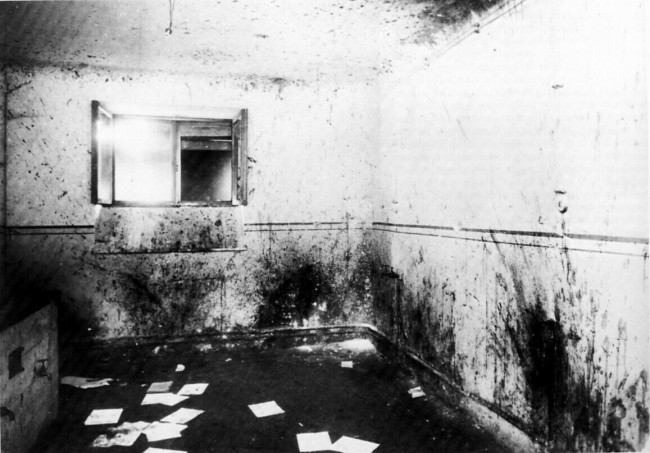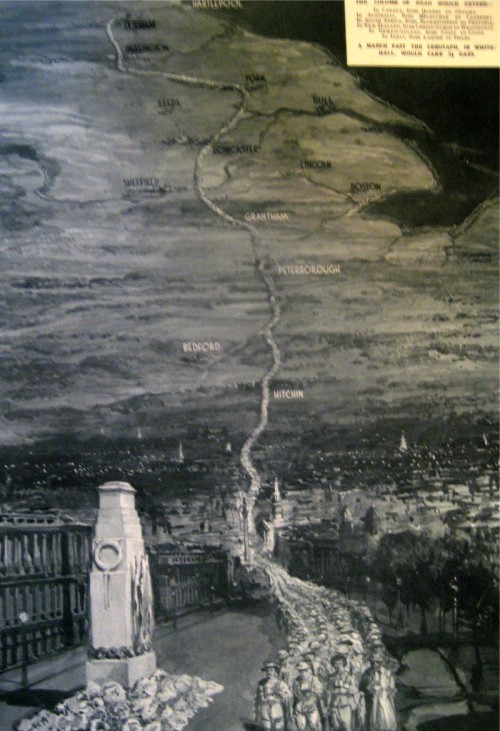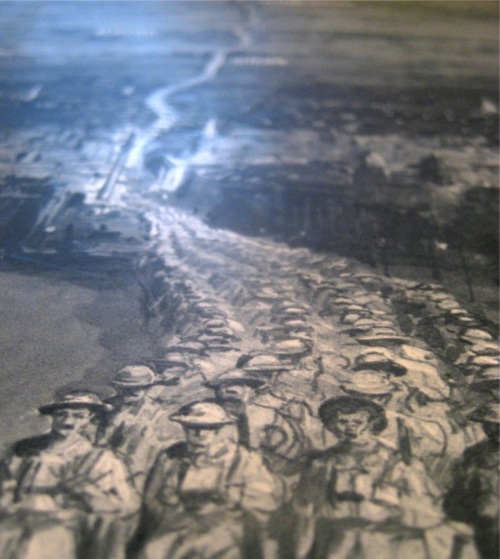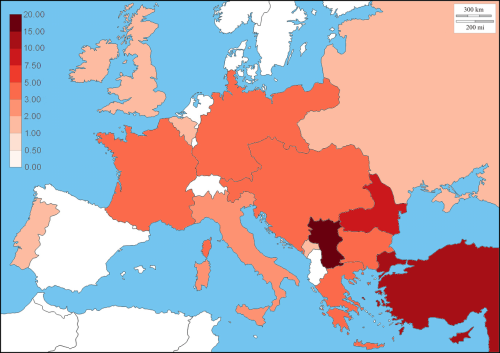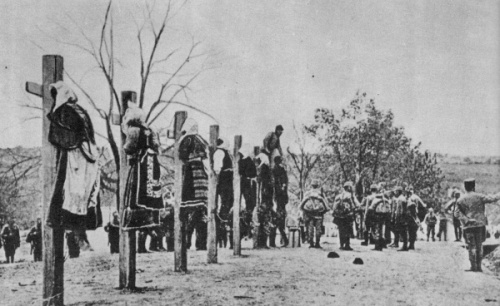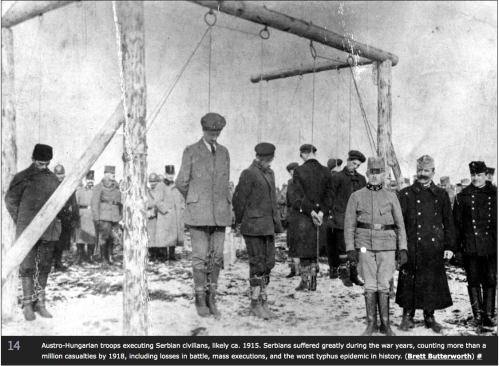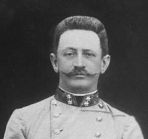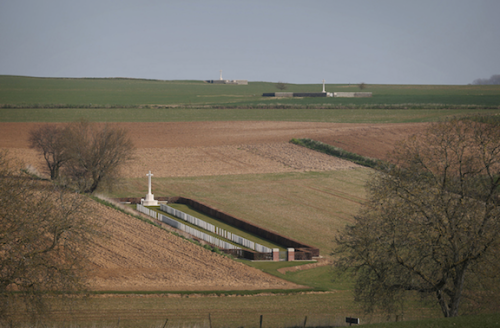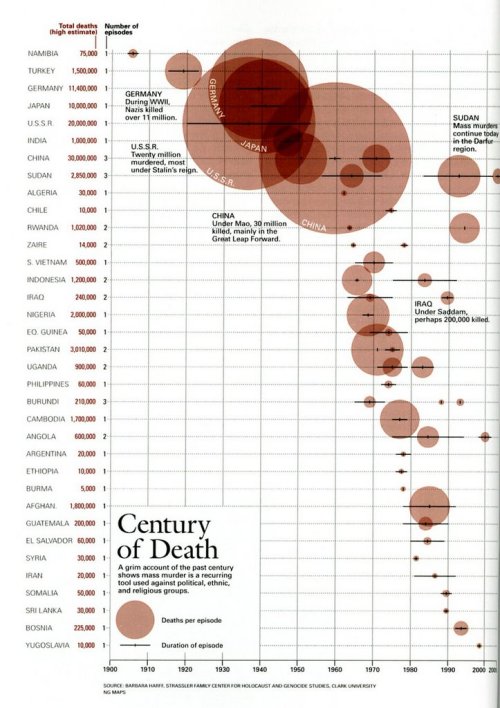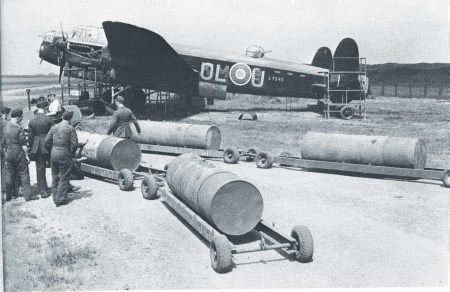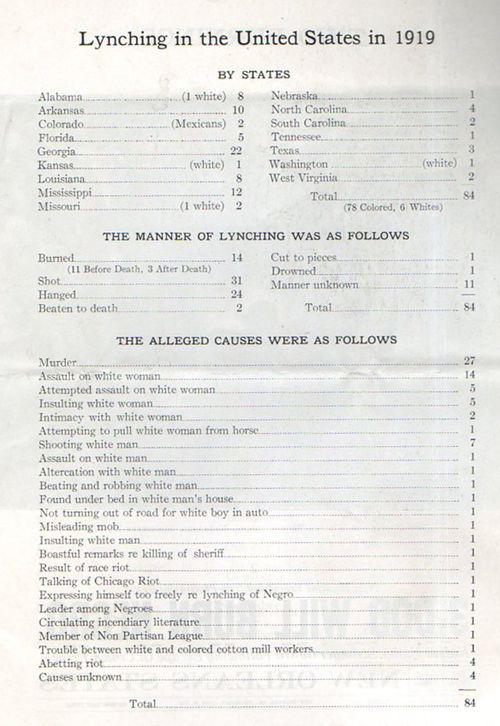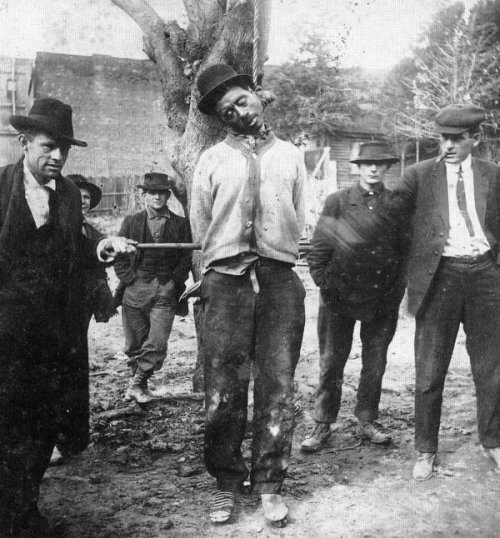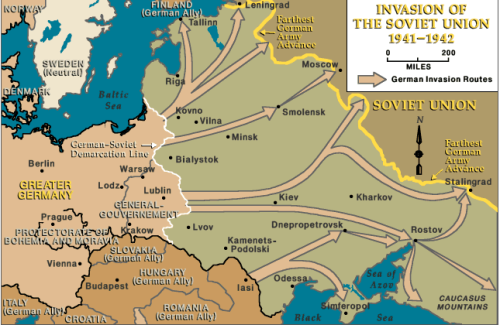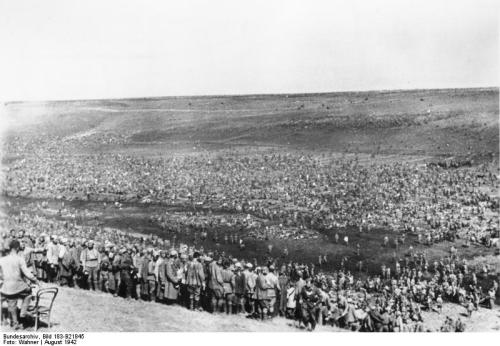A long line of dead men
A chilling image, but can it be right that the column would be 269 miles long?
The dead are marching four abreast so 1,104,890 divided by 4 gives 276,222 rows. There are 5,280 feet in a mile and 1,420,320 feet in 269 miles. If we divide 1,420,320 by the 275,222 rows it gives 5.142 feet for each row. That sounds about right. If marching men are too close together they would be constantly stumbling into each other.
So, the marching war dead of the British Empire [Britain, Canada, Australia, New Zealand, India and other smaller countries] would produce a column 269 miles long.
In the top right hand corner of the image there is a small yellow box. This gives equivalent distances for other Empire countries. For example, the column would stretch from Quebec to Ottawa. It also gives the time needed for the column to march past the Cenotaph war memorial in London. I cannot read the number but it is easy to calculate.
British Army Field Service Regulations gives a infantry marching speed of 294 feet per minute [3.3 miles per hour]. At that speed it would take 18 minutes for one mile of the column to pass the Cenotaph and 18 x 269 = 4,842 minutes [3 days, 8.6 hours] for all the column to pass.
Similar columns for the total military dead [casualty figures from Wikipedia] for other countries.
France 340 miles [127% of the BE figure]
Germany 486 miles [181% of the BE figure]
USA 28 miles [10.4% of the BE figure]
On the 1st July 1916, the first day of the Battle of the Somme, the British Army suffered 57,470 casualties, including 19,240 dead. The dead from that day would form a column 4.68 miles [7.53 kilometres] long.
Filed under Forgotten history
Balkan Tragedy
The map below shows World War One casualties [civilian and military] as a percentage of a country’s population. The darker the colour the higher the percentage. The country with the highest national casualty rate was Serbia. France lost 16.8%, Germany 15.4%, Russia 11.5%, Italy 10.3% and USA 0.13%.
Serbia lost 27% of its overall population and 60% of its male population. A total of more than 1,100,000 people.
The nation responsible for these losses was the Hapsburg state of Austria-Hungary.
Austria-Hungary was not only responsible for the Serbian losses but, in the minds of many historians, for starting the First World War. Germany may have been a wiling accomplice but Austria-Hungary was the instigator [see Watson, A., 2014. Ring of Steel: Germany and Austria-Hungary at War, 1914-1918, London: Allen Lane.]. Austria-Hungary attacked Serbia [after giving them an ultimatum that they knew the Serbs could not accept]. Russia moved to assist Serbia and, thanks to a series of existing treaties France, Britain, Germany and Italy were dragged into the conflict.
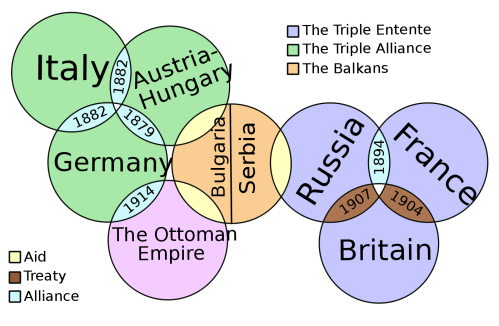 Austria-Hungary invaded Serbia. As well as being swine they were also incompetent and initially they suffered heavy losses. However, Austria-Hungary had more men and guns and in time they were able to defeat the Serbian Army so completely that about 155,000 survivors had to be evacuated to Greece by British ships.
Austria-Hungary invaded Serbia. As well as being swine they were also incompetent and initially they suffered heavy losses. However, Austria-Hungary had more men and guns and in time they were able to defeat the Serbian Army so completely that about 155,000 survivors had to be evacuated to Greece by British ships.
That left the Serbian population at the mercy of the Austro-Hungarians who carried out numerous atrocities. Concentration camps were set up, there were mass hangings, crops were destroyed and wells poisoned. In addition to all this Serbia suffered a severe typhoid epidemic.
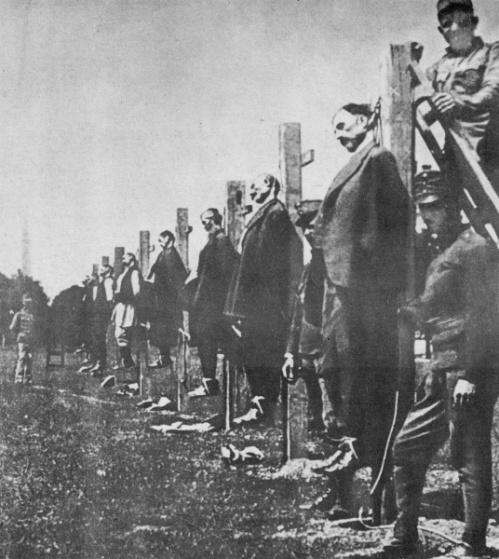 In 1915 Bulgaria also invaded Serbia and carried out its own series of atrocities, including the massacre at Surdulica.
In 1915 Bulgaria also invaded Serbia and carried out its own series of atrocities, including the massacre at Surdulica.
At the end of WW2 some war criminals were executed. Things were different after the First World War. Count Berchtold, the Austro-Hungarian Foreign Minister, who was more responsible than any other for the start of WW1 was allowed to retire to his estates in Hungary where he lived until 1942.
Von Hotzendorf was Chief of the Hapsburg General Staff and a war criminal. He was allowed to make a fortune from his memoirs and lived comfortably in the German spa town of Bad Mergentheim.
Only a few minor war criminals stood trial and none were executed.
Filed under Uncategorized
A trying day on the Somme
On the 1st July 1916 the British Army attacked the German Army along the line of the Somme. The aim was to relieve pressure on the French at Verdun. The result was the greatest disaster in British military history. At the end of the day the British had suffered 57,470 casualties, including 19,240 dead.
The losses were particularly heavy along the northern part of the line. The Newfoundland Regiment was wiped out before Beaumont-Hamel. It suffered the worst losses of the day. “A great many fell before they even crossed the British line. Many more were hit as they picked their way through the gaps in the British wire. With exemplary courage, the survivors picked up their assault formations as best they could and “with chins tucked down as if walking into a blizzard” continued toward the German line about 400 metres further on”.
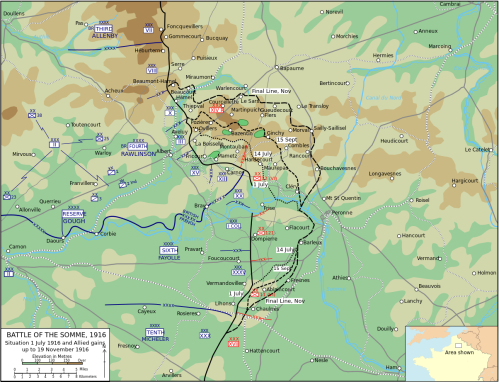 Several Pals battalions from the north of England suffered very heavy losses attacking the fortified hamlet of Serre.
Several Pals battalions from the north of England suffered very heavy losses attacking the fortified hamlet of Serre.
The Pals battalions suffered particularly heavy losses all along the Somme. These volunteer units had been raised with the promise that recruits could serve alongside men from their own town [e.g. the Accrington Pals], the same school [The “Grimsby Chums” was formed by former schoolboys of Wintringham Secondary School in Grimsby] and the same organisation [Glasgow Trams]. There was even a Stockbrokers’ Battalion.
Filed under Uncategorized
Operation Starvation
Operation Starvation
 Operation Starvation was a WW2 American campaign to starve Japan into surrender by dropping 12,000 mines from B-29s into the narrow entrances to the Inland Sea and off Japanese ports. The idea was to deprive industry of coal, oil and raw materials and civilians of food. [see Lessons from an Ariel Mining Campaign. Project RAND. 1974. and
Operation Starvation was a WW2 American campaign to starve Japan into surrender by dropping 12,000 mines from B-29s into the narrow entrances to the Inland Sea and off Japanese ports. The idea was to deprive industry of coal, oil and raw materials and civilians of food. [see Lessons from an Ariel Mining Campaign. Project RAND. 1974. and
Operation Starvation. G A Mason. 2002.]
It is one of those historical events which I have never seen portrayed in a book, documentary or movie. Yet it was extremely effective. The mines sank or damaged 670 ships totalling more than 1,250,000 tons for the loss of only fifteen B-29s. Even more shipping capacity was lost because ships were held in port waiting for mines to be cleared.
Operation Starvation was part of one of three strategic options for ending the war against Japan. Continue reading
Filed under Uncategorized
Firestorm
The nine Windows Openers aircraft were the first to arrive over the darkened city. The Mosquitos had been marking the route from the coast for the Main Force bombers, now they began illuminating the target area with bombs and flares. They also dropped Window [aluminised-paper strips] to confuse enemy radar and provided information on weather conditions, particularly wind speed and cloud cover.
Soon after 24 Blind Marker-Illuminators and 62 Supporters arrived. The Blind Marker-Illuminator [aka fire starters] Lancasters were flown by elite crews and carried radar. Their task was to mark the target area for the 800 aircraft of the Main Force; to set out a box in which, if all went according to plan, tens of thousands of people would die. Continue reading
Filed under Uncategorized
Workhouse
Before the welfare state Britain had the workhouses. These were places were the indigent could be taken off the streets and provided with food and shelter.
This is the workhouse in Ripon in Yorkshire. It was built in 1854. Part of it is a museum and the rest is used as accommodation for Ripon’s Social Services Departments.
Life in a workhouse was intended to be harsh, to deter the able-bodied poor and to ensure that only the truly desperate destitute would apply. Poverty was seen as the fault of the poor and deserving of punishment. A philosophy that would seem familiar to some US Republicans and UK Conservatives.
Demand for accommodation often exceeded its supply so supply was rationed by making the workhouses unpleasant. Sometimes very unpleasant.
Filed under Uncategorized
Lynching
Lynching was employed as a means of social control in the South of the United States. Approximately 3,500 blacks and 1,300 whites were lynched between 1882 and 1968, most of them from 1882 to 1920. [University of Missouri-Kansas City School of Law].
Filed under Uncategorized
The WW2 Russian Prisoner of War Holocaust
This post is about Nazi Germany’s murder of millions of Russian prisoners of war. A mass murder to compare with the concentration camp killings.
In Summer 1941 Germany launched Operation Barbarossa, the invasion of the Soviet Union. In the following months they won a series of battles of encirclement. Few in the West have heard of these but they were military victories on a scale that the world had not seen before and has not seen since. They were only possible between such unmatched foes and in the vast steppes of Russia.
These victories produced huge numbers of prisoners of war.
Vyazma and Bryansk 512,000
Kiev 452,000
Smolensk 300,000
Bialystok/Minsk 290,000
Uman 103,000
During the war in Russia German forces captured 5,700,000 Russian POWs. About 3.3 million of the POWs died in German camps, 2.8 million of them in the short period between the start of Barbarossa and the Spring of 1942.
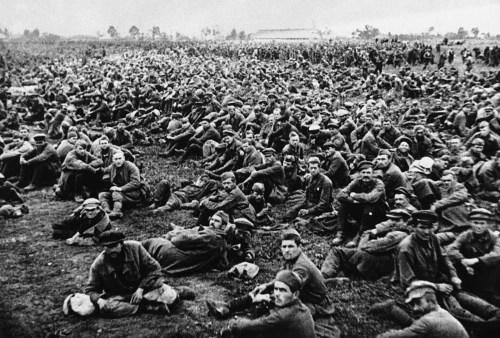
Some of the 650,000 Russian prisoners captured at Bryansk and Vyasma
About half a million escaped from the camps or were liberated by the advancing Red Army. About a million were taken as forced labour when manpower shortages started to hit the German economy. Finally, some 930,000 more were found alive in the camps after the war.
Some were shot or gassed. In Gross-Rosen concentration camp the SS killed more than 65,000 Soviet POWs by starvation. In Flossenbürg, they burned Soviet POWs alive. In Majdanek, they shot them in trenches.
However, the vast majority were killed in Dulags [POW transit camps] and Stalags [POW camps] by starvation, desease and exposure. The Germans set up a number of camps, usually by doing nothing more than stringing up some barbed wire. Prisoners were herded inside and then left in the open with little or no food, sanitation or shelter. Starvation, exposure and epidemics (especially typhoid and dysentery) did the rest.
Filed under Uncategorized

